
The caddisflies, or order Trichoptera, are a group of insects with aquatic larvae and terrestrial adults. There are approximately 14,500 described species, most of which can be divided into the suborders Integripalpia and Annulipalpia on the basis of the adult mouthparts. Integripalpian larvae construct a portable casing to protect themselves as they move around looking for food, while annulipalpian larvae make themselves a fixed retreat in which they remain, waiting for food to come to them. The affinities of the small third suborder Spicipalpia are unclear, and molecular analysis suggests it may not be monophyletic. Also called sedge-flies or rail-flies, the adults are small moth-like insects with two pairs of hairy membranous wings. They are closely related to the Lepidoptera which have scales on their wings; the two orders together form the superorder Amphiesmenoptera.
Robert McLachlan FRS was an English entomologist specializing in the study of lacewings (Neuroptera) and caddisflies (Trichoptera).

The family Leptoceridae are a family of caddisflies often called "long-horned caddisflies". Leptoceridae is the second largest family of caddisflies with more than 1500 species in around 45 genera. The main identifying feature of most Leptoceridae is that their antennae are longer than those of other caddisflies. There is one genus with short antennae (Ceraclea), but it is easily identified by the pair of dark curved lines on the mesonotum.
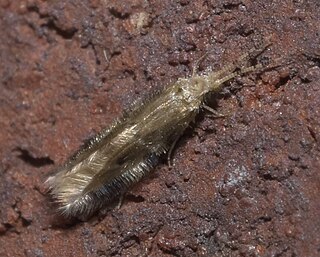
The Hydroptilidae are a large family of caddisflies (Trichoptera) with a worldwide distribution. They are commonly known as microcaddisflies or purse-case caddisflies, in reference to two characteristic traits of this family: Hydroptilidae are much smaller than other caddisflies, rarely exceeding 5 mm (0.20 in) in length. Their larvae do not build a protective case until the final instar of their growth. At that time however, they build a typically Purse-shaped case, either portable or stuck to the substrate, in which the larva finishes growth and pupates.

The Ecnomidae are a family of caddisflies comprising 9 genera with a total of 375 species.
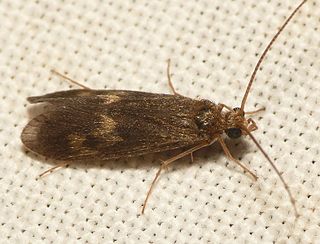
The Polycentropodidae are a family of trumpet-net and tube-making caddisflies. There are at least 30 genera and 720 described species in Polycentropodidae. The type genus for Polycentropodidae is Polycentropus J. Curtis, 1835.

The Psychomyiidae are a family of tube-making caddisflies. Members of this family are typically very similar to polycentropodids, most of them can be differentiated by the spur formula is 2-4-4, thyridial cell short, absence of the forewing fork I, and hindwing forks I and IV. Male genitalia has elongate preanal appendages, and reduced tergum IX. The larvae differ by the submental sclerites separated, foretrochantin broad, and the pupal mandible apex whip-like. Larvae construct long silken galleries.

Brachycentridae is a family of humpless casemaker caddisflies in the order Trichoptera. It is found in North America, Europe, and Asia. Georg Ulmer first described it in Germany in 1903 as a subfamily of Sericostomatidae. The type genus for Brachycentridae is Brachycentrus J. Curtis, 1834.

Uenoidae is a family of stonecase caddisflies in the order Trichoptera. There are about 7 genera and at least 80 described species in Uenoidae.
Gumaga is a genus of bushtailed caddisflies in the family Sericostomatidae. There are about six described species in Gumaga.

Limnephilini is a tribe of northern caddisflies in the family Limnephilidae. There are about 16 genera and at least 300 described species in Limnephilini.
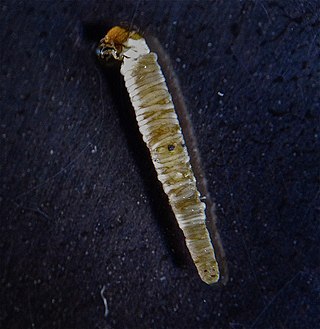
Micrasema is a genus of humpless casemaker caddisflies in the family Brachycentridae. There are more than 70 described species in Micrasema.

Mystacides is a genus of long-horned caddisflies in the family Leptoceridae. There are more than 20 described species in Mystacides.

Brachycentrus is a genus of humpless casemaker caddisflies in the family Brachycentridae. There are at least 30 described species in Brachycentrus.

Stenophylacini is a tribe of northern caddisflies in the family Limnephilidae. There are at least 20 genera and 190 described species in Stenophylacini.

Limnephilinae is a subfamily of northern caddisflies in the family Limnephilidae. There are at least 65 genera and 600 described species in Limnephilinae.

Chilostigmini is a tribe of northern caddisflies in the family Limnephilidae. There are about 12 genera and at least 40 described species in Chilostigmini.
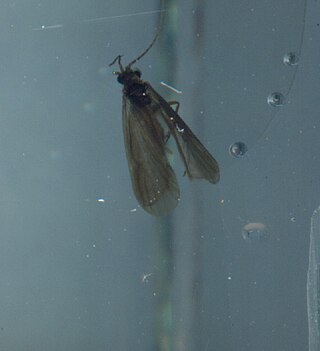
Lype is a genus of net tube caddisflies in the family Psychomyiidae. There are more than 20 described species in Lype.

Agraylea is a genus of microcaddisflies in the family Hydroptilidae. There are more than 20 described species in Agraylea.
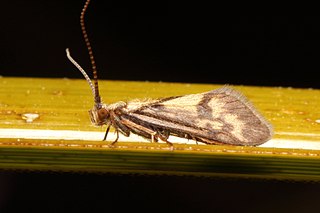
Conoesucidae is a family of caddisflies in the order Trichoptera. There are about 12 genera and more than 40 described species in Conoesucidae.

















